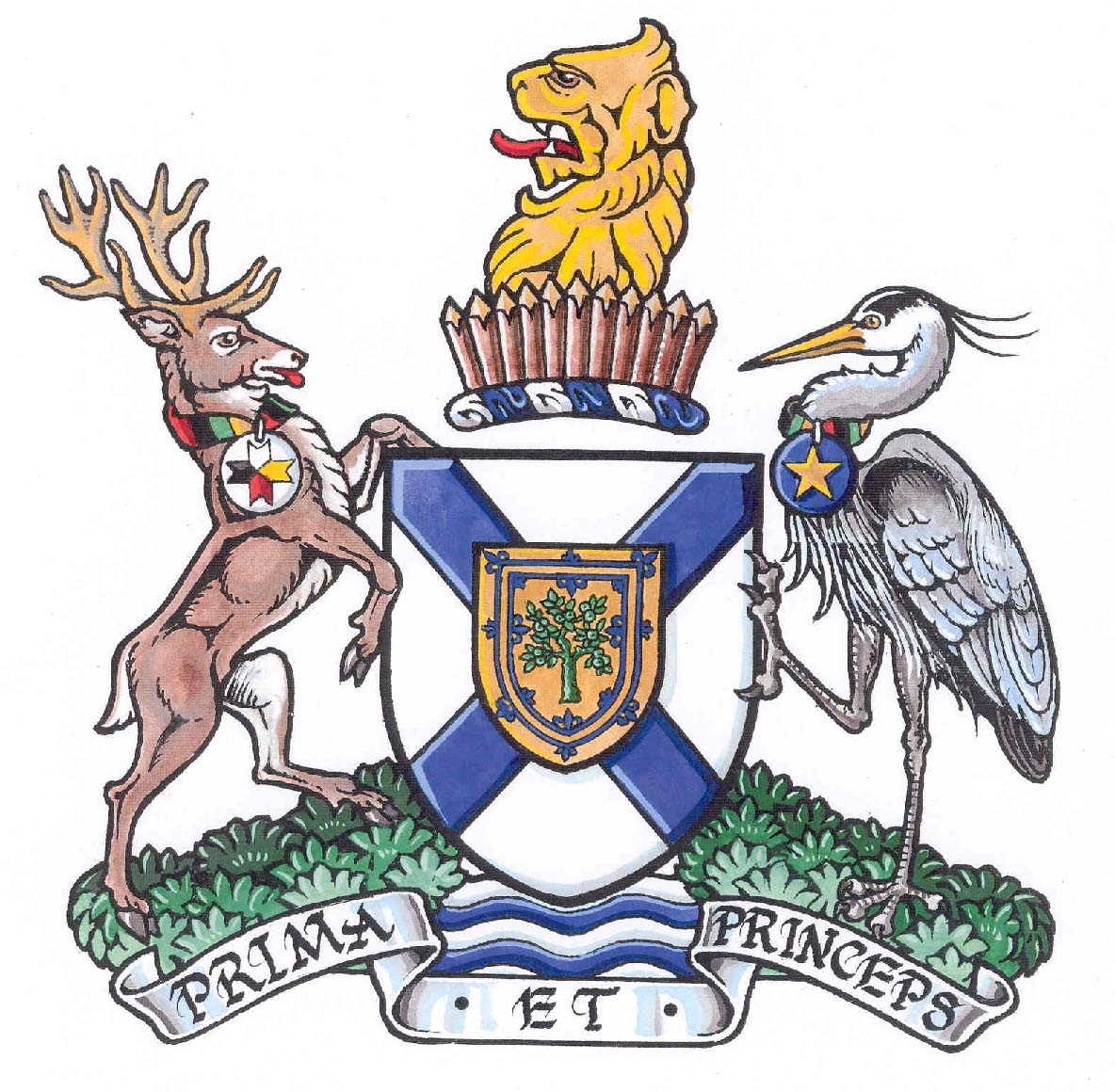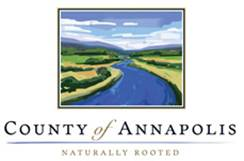History of the Coat of Arms

Arms: The shield is white and on it is a large blue diagonal cross. At the centre is a gold shield bearing an apple tree in green. Running parallel to the edge of this smaller shield is a blue “double tressure” - two narrow lines decorated with fleur-de-lis shapes, some pointing outwards, some in.
The blue and white are the provincial colours of Nova Scotia, and the basic design of this shield echoes the provincial arms. The double tressure on the smaller shield is based on the Royal Arms of Scotland, and can therefore be taken as a reference to the County’s namesake, Queen Anne. The apple tree indicates that the Annapolis Valley is famous for producing fruit.
Crest: A palisade of wooden stakes (depicted here as eleven) sharpened at the top, out of which emerges a gold lion’s head. This is set on a wreath of twisted cloth in white and blue. The wooden stakes indicate the fortification of Port Royal, the first European settlement in Canada. By depicting eleven of them, a reference is made to the eleven districts of the County. The lion is indicative of the subsequent British presence in the area, as well as the fact that the County and its major center (Annapolis Royal) are named after Queen Anne.
Supporters: On the left of the shield is a white-tailed deer and on the right is a great blue heron, both in their natural colours and both with collars of red, black, green and gold around their necks. Suspended from the deer’s collar is a white disc bearing a Mi’kmaq star of eight points, divided into white, gold, red, and black sections. Suspended from the heron’s collar is a blue disc on which is a gold star. The supporters stand on two grassy mounds above blue and white waves.
The supporters are prominent local creatures. The Mi’kmaq star honours the first inhabitants of the area. The gold star is the symbol of Acadia, thus honouring the Acadian settlers of the seventeenth and eighteenth centuries.The collars use the colours of African heritage, and thus mark the contributions African-Canadian inhabitants have made to the area over the centuries, beginning with Mathieu DeCosta.The two grassy mounds represent the geographical features in Annapolis County of the North and South Mountains. The water at the bottom represents the Bay of Fundy and the Annapolis River running through the valley. The water and grassy mounds also represent the County’s primary industries of fishing, farming and forestry.
Supporters: On the left of the shield is a white-tailed deer and on the right is a great blue heron, both in their natural colours and both with collars of red, black, green and gold around their necks. Suspended from the deer’s collar is a white disc bearing a Mi’kmaq star of eight points, divided into white, gold, red, and black sections. Suspended from the heron’s collar is a blue disc on which is a gold star. The supporters stand on two grassy mounds above blue and white waves.
The supporters are prominent local creatures. The Mi’kmaq star honours the first inhabitants of the area. The gold star is the symbol of Acadia, thus honouring the Acadian settlers of the seventeenth and eighteenth centuries.The collars use the colours of African heritage, and thus mark the contributions African-Canadian inhabitants have made to the area over the centuries, beginning with Mathieu DeCosta.The two grassy mounds represent the geographical features in Annapolis County of the North and South Mountains. The water at the bottom represents the Bay of Fundy and the Annapolis River running through the valley. The water and grassy mounds also represent the County’s primary industries of fishing, farming and forestry.
Motto: PRIMUS ET PRINCEPS is a Latin phrase meaning “First and foremost”. This was suggested by the County, and it refers to the fact that the County was the site of the first permanent European settlement in Canada, as well as numerous “firsts” in the country.
Flag: The shield of arms is arranged as a rectangular flag.
As a legacy project, Municipal Council tasked the Heritage Advisory Committee to develop a municipal coat of arms. After public meetings, work with an artist and consultation with the Heraldic Authority for a period of several years, Municipal Council adopted the Coat of Arm and Flag as seen here.
On Monday, February 26, 2006 (National Heritage Day) the official Coat of Arms and Flag were unveiled at the Annapolis Royal Provincial Court House. Greetings were read from Her Excellency, the Right Honourable Adrienne Clarkson; and Her Honour, the Honourable Myra Freeman was in attendance for this prestigious occasion.
There is a policy in place governing the (limited) use of the Municipal Coat of Arms. To read it Click Here



